Compact strike: American portable anti-tank weapons
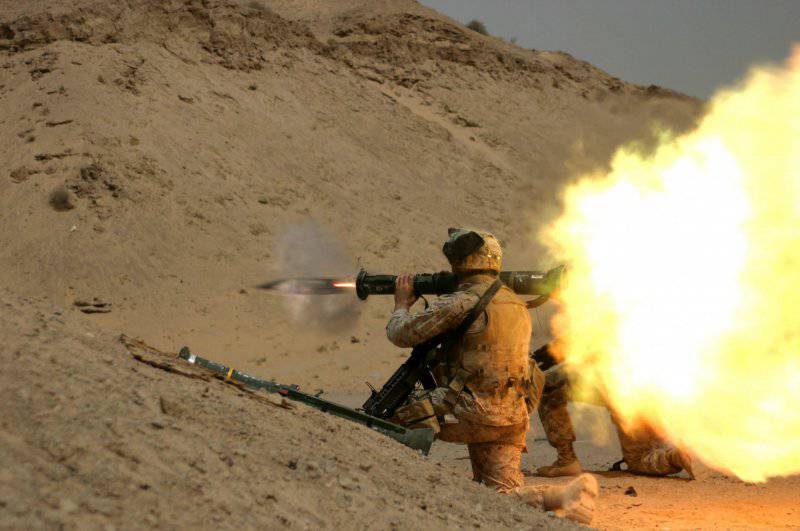
The AT-4 backward blast can damage equipment or seriously injure personnel near the rear of the launcher. Instructors and soldiers must avoid danger zones of the return shock wave, and also follow other restrictions during firing.
On modern mixed battlefields, the threats facing the United States and its allies are different: a dynamic combination of conventional, irregular, terrorist, and criminal forces. In Afghanistan (and earlier in Iraq) most of these clashes happen in a short time and at close range. More than ever, light, shoulder-launched or portable, guided and unmanaged systems prove their usefulness in battles in built-up areas. To defeat this deadly near space, small units must destroy the enemy with weapons that they can carry. In order to meet their needs for portable firepower, American troops arm themselves with various weapons, which, although originally intended to combat tanks, is effective against a wide range of goals.
Whether the target is an enemy tank, vehicle, bunker, structure, or personnel, portable anti-tank weapons are vital for victory in close encounters on a mixed battlefield. Although various target designation systems tested in combat conditions made it possible for a dispersed soldier to obtain accurate firepower from the sky, allowing one person with the appropriate tools to set targets and attract air or artillery fire to an unprecedented scale on a target on the ground, nevertheless, fighting in the near distances require fire power that you can carry on yourself.
There are two general categories of portable weapons: individual missiles launched from the shoulder or recoilless cannons, mostly unguided; as well as serviced rocket complexes. All this is available in the arsenal of the US Army. Individual weapons are, by definition, light enough for one person to carry and maintain, while missile systems serviced by calculations require at least two people to transport and operate, while the heaviest models are most likely to be transported on vehicles.
Individual weapons for shooting from the shoulder
Anti-tank complex M72A7 LAW
M72A7 LAW (Light Anti Tank Weapon - light anti-tank weapons) is an improved version of the M72 light armor-piercing rocket launcher from the Vietnam War. The M72 LAW was supposed to be replaced with the M136 AT4 system (see below), but again went into service with the army for fighting in Iraq and Afghanistan because of its light weight and effectiveness in melee combat. The Advanced M72A7 is a compact, portable, lightweight, single-shot, disposable shoulder system with a family of warheads optimized for hitting lightly armored vehicles and other reinforced targets at short distances. From it can shoot from any shoulder. The M72A7 consists of an unguided 66-mm rocket, pre-packaged in a telescopic, disposable launcher at the factory. Improved features of the newest M72A7 complex include a more powerful rocket engine, which increases the range, a warhead with increased mortality, a smaller and more consistent effort to descend from a platoon, rifle-type sight and better overall reliability and safety of the complex.
The upgraded M72 complex weighs 3,6 kg, has a maximum range of 1400 meters and can penetrate 300 mm rolled homogeneous steel armor (RHA), it is also effective against bunkers, buildings and personnel. The rear danger zone behind the weapon is 70 m. The back blast wave can damage equipment and injure personnel behind the launcher. The LAW complex requires at least 10 meters to start. The M72A7 LAW complex is produced as ammunition and does not require maintenance.
The M72A7 complex is well adapted for shooting at enemy buildings and supporting points, but it may not break through a wall of two bricks with a support of 1,2 meter thick sandbags. Of all the building materials, heavy stone is the hardest to punch. LAW will not be able to break through the stone walls of European style. The only consequence when breaking through thick stone walls is the formation of craters on the surface of the wall.
Other options for the new and upgraded LAW complex include: M72A8 LAW FFE (Fire From Enclosure), which has a propulsion system modified to shoot from inside buildings, M72A9 LAW ASM (Anti-Structure Munition - armament for destruction of buildings) with concrete warhead with a standard rocket engine and M72A10 LAW ASM FFE with a rocket engine like the M72A8 LAW FFE.
LAW is manufactured by Nammo Talley Defense, Inc. In 2011, Nammo Talley Defense was awarded a 15,5 million-dollar contract for the production and supply of LAW M7750A72 portable missiles from the command of the Marine Corps in Quontico to replace existing stockpiles.
Complex Mk153 SMAW
MK153 SMAW (Shoulder launched Multipurpose Assault Weapon - universal assault armament launched from the shoulder) - another shoulder complex manufactured by Nammo Talley based on the Israeli IMI B-300 is a reusable 83-mm launcher with a length of about 78 cm and 7,5 kg. It is equipped with an 9 sighting rifle and a mount for optical night or laser sights. SMAW rockets are packaged in a tube-container that connects to the launcher before firing and works as an addition to the launch tube. SMAW also comes in several configurations: SMAW-D, SMAW-D (CS) and SMAW-NE.
SMAW-D
The SMAW-D complex (known as M141) Bunker Defeat Munition (BDM - ammunition for the destruction of dugouts and bunkers) is a single-shot, one-time version of SMAW. The launcher is an elongated tube with integrated optics. The missile has a HEDP (High Explosive Dual Purpose - high explosive dual-use) warhead with dual fuze mode and X-NUMX A-2,38 explosives, which is optimized for use against targets such as fortifications (earth and log dug-outs). It is also capable of breaking through concrete block walls and neutralizing light armored vehicles at a distance of 3 – 15 meters. SMAW-D has been successfully applied in recent operations, including in particular the destruction of enemy positions in caves.
A useful feature of the SMAW-D complex is that it can be fired at armored or unarmored targets without any actions to select the targets, which are often performed by the shooter. The firing of the warhead, instantaneous or delayed detonation, is automatically detected by the fuse at the moment when the rocket meets the target. This automatic mode ensures that the most effective mechanism of destruction is applied. Warhead detonation is instantaneous if a solid target is hit, such as a brick or concrete wall or an armored vehicle, while striking a softer target, such as a bunker lined with sandbags, leads to a temporary delay of the fuse, which allows the rocket to pierce the target before the detonation of the warhead.
The SMAW-D complex can destroy bunkers, but it is not optimized for the destruction of personnel inside concrete structures in urban areas or armored vehicles. He can pierce the stone walls, but this may require universal projectiles to defeat the enemy located behind the walls.
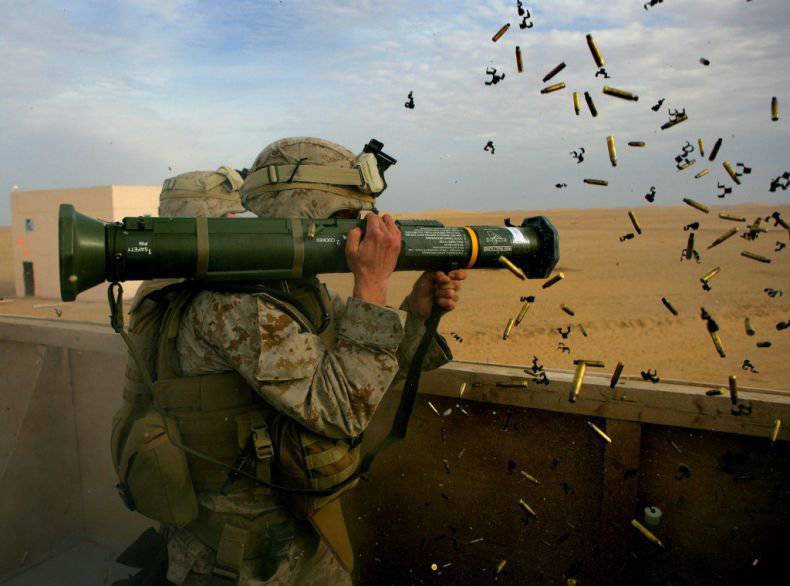
Marine shoots from an AT-4 installation during live firing at a test site in Kuwait in January 2008
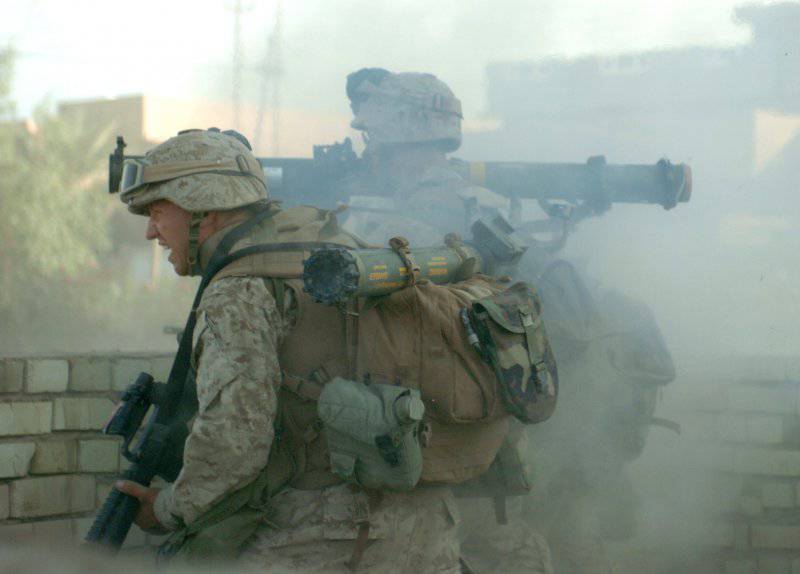
After creating a passage in the wall for infantrymen, the younger corporal Fernandez shoots his MK-153 SMAW right behind Corporal Ullom on the suspicious rebel stronghold
SMAW-NE complex
SMAW-NE (SMAW - Novel Explosive - a new explosive) was developed for the American marines by the center of the surface of the Navy in Dahlgren, and Talley Defense Systems has created an improved thermobaric warhead. A very successful collaboration on the development of SMAW-NE has taken only 9 months from the beginning of concept development to the deployment of this complex. The complex has proven itself very well when used in Iraq, for example in the destruction of large single-story stone buildings from a distance of 100 m, but combat reports indicate that sometimes it was necessary to use several projectiles. Due to the lack of penetrating power of an NE-projectile, it was necessary to shoot the first dual-purpose missile in order to create a hole in the wall or structure. This blasting was instantly followed by an NE-projectile, which could burn a target or literally demolish the entire floor of a building.
Complex SMAW-D (CS)
SMAW-D (CS) (SMAW-Disposable Confined Space - one-time in a limited space) is a product of a modernization program designed to enhance the performance of SMAW-D, which allows it to be used inside buildings and other closed spaces.
M136 AT4 Complex
M136 AT4 and AT4-CS Anti-Structure Tandem (AST - tandem warhead for the destruction of buildings) - this is a light, autonomous, shoulder armament caliber 84 mm based on the principle of recoilless gun. The complex consists of a stabilized free-flight grenade, packed in a disposable monoblock fiberglass case. AT4 can only be shot from the right shoulder. Its length is 102 mm, weight 6,7 kg (launcher and rocket) and has a valid range from 15 meters (combat minimum) to 300 meters (maximum range). The rear danger zone behind the weapon is 65 meters in the 90 ° sector. The HEN 84-mm warhead provides superior performance and lethality for post-impact exposure.
In order to increase the applicability of the complex in urban combat, the PM CCS (Project Manager Close Combat Systems) melee systems agency canceled the purchase of AT4 in favor of its latest iteration - the AT4 Confined Space complex (CS - limited space). It uses a modified low-impact principle, while the forward force of inertia of the projectile is not balanced by the mass of driving gases emitted from the rear of the barrel, as in the standard AT4, but rather by the counterbalancing mass. The mass of the complex increased to 7,5 kg.
Complex PREDATOR
The PREDATOR SRAW short-range assault weapon (Short Range Assault Weapon), designated FGM-172 SRAW, is a solid-propellant rocket, manually guided and fired from a disposable shoulder launcher. The SRAW complex was designed by Lockheed Martin as an inexpensive addition to the larger and more complex anti-tank missile FGM-148 JAVELIN, but in 2003, further purchases were canceled. In 2004, Lockheed Martin received a contract from the US Marine Corps to retrofit all remaining SRAW projectiles to the FGM-172B SRAW-MPV (Multi-Purpose Variant - Multi-Purpose) configuration with a new multi-purpose fragmentation warhead that changed the designation of the anti-tank system installation on direct-fire for urban conditions. The US Army evaluated the modification PREDATOR SRAW with a universal warhead for its requirements MPIM (Multipurpose Individual Munition - universal individual ammunition), and its KESTREL variant with a direct-action warhead unsuccessfully participated in the next generation British armor-piercing armament.
The PREDATOR uses a “soft start” rocket propulsion unit with low initial load, so that the weapon can be safe when shooting from closed positions, it has an inertial guidance system that provides shot-and-forget characteristics. During aiming, the autopilot of the inertial reference system determines the angular motion of the target and during the flight it directs the rocket to the appropriate position over the intended location of the target. The missile carries a striking part of the top, very similar to the BGM-71F TOW 2B, it is activated by a double touch fuse (laser and magnet) in the nose of the rocket.
The entire complex ready for firing, including a missile and a launcher, weighs 9,7 kg. The min / max range is 17 meters and 600 meters respectively.
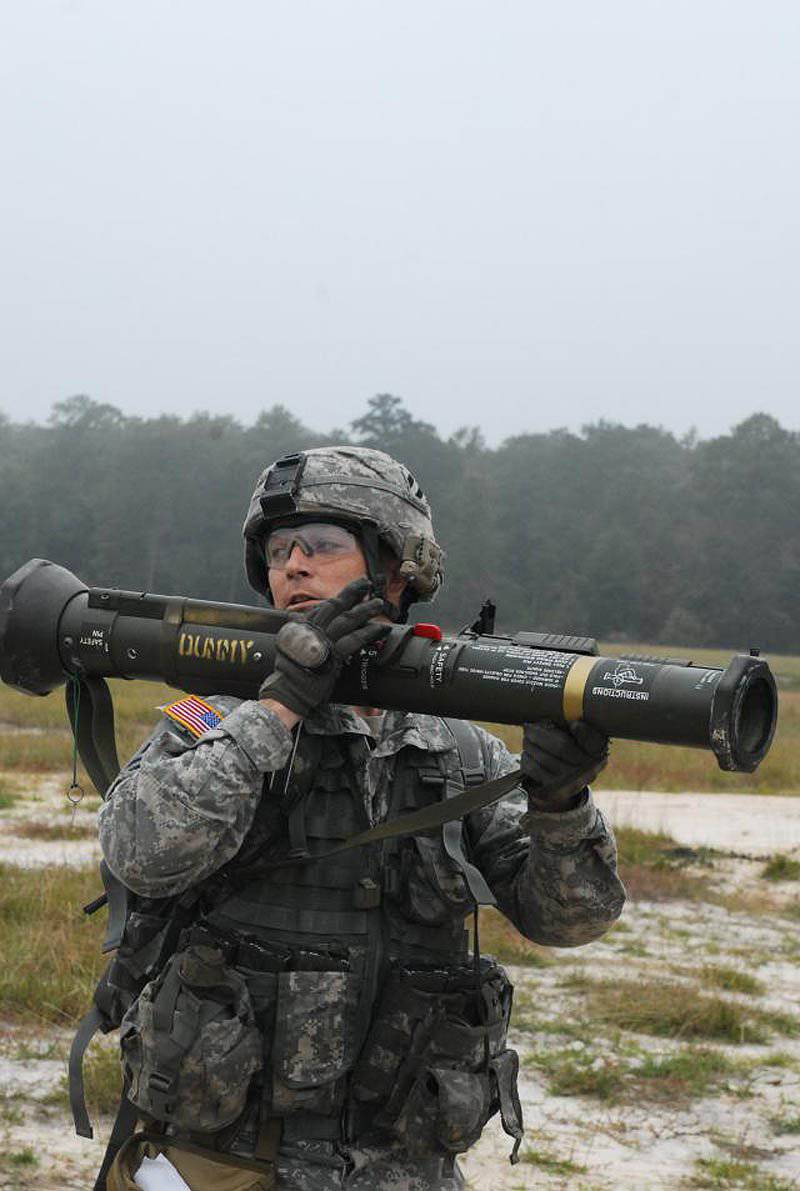
A sergeant from the 4 Brigade is trying to "shoot" from M136 AT4 during an exercise in the city in October 2009
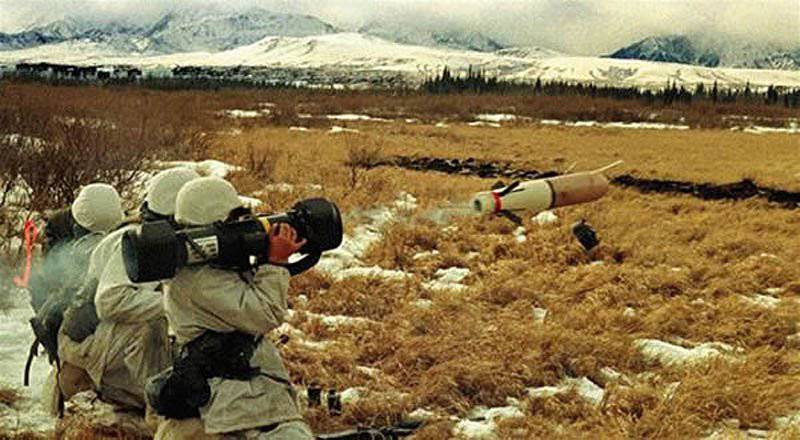
The FGM-172 SRAW complex, also known as PREDATOR SRAW, was developed by Lockheed Martin.
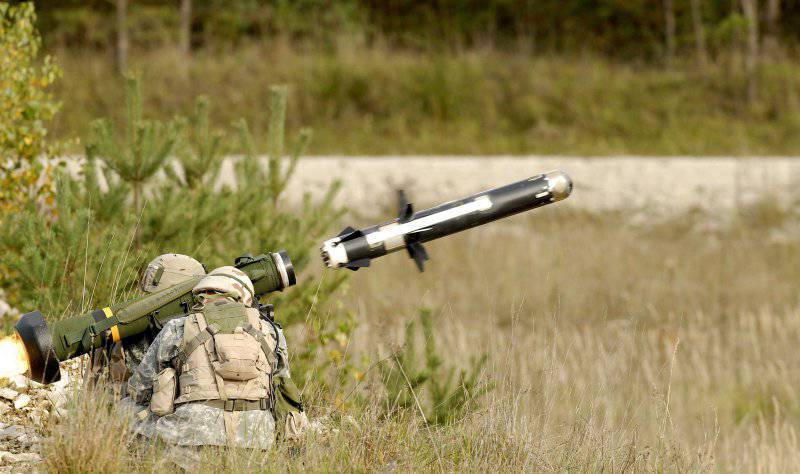
FGM-148 Javelin is a portable anti-tank complex that entered the US Army in 1996 to replace the Dragon anti-tank complex.
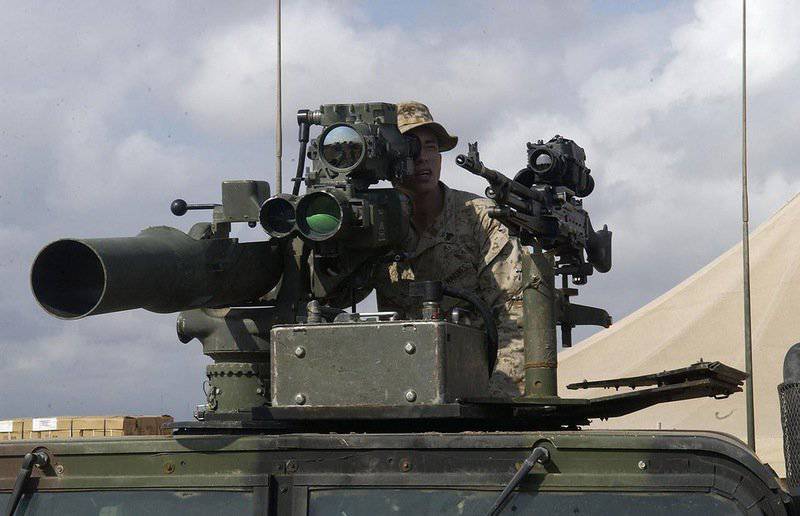
The Honorable TOW complex has been involved in various wars since its debut in the 70s. It is in service in five versions of missiles and two control options. This complex is expected to remain in service until 2025.
Rocket systems serviced by calculation
JAVELIN
FGM-148 JAVELIN is probably the main US anti-tank complex and has now been exported to 10 countries: Australia, the Czech Republic, Jordan, Ireland, Lithuania, New Zealand, Norway, Oman, Taiwan and the UK. JAVELIN was designed and manufactured for the US Army and Marine Corps by the JAVELIN joint venture formed by Lockheed Martin and Raytheon.
The JAVELIN complex is a light, portable, anti-tank system of the middle class of the “shot-and-forget” type, designed to destroy armored vehicles at a distance of up to 2000 meters. The rocket is shot from the shoulder and can be used by one operator, but is usually deployed by the calculation of two or three people. The JAVELIN complex can be deployed for secondary fire support tasks against point targets, such as bunkers and weapons, serviced by calculations; He can also destroy helicopters in direct attack mode. In addition, the JAVELIN complex (Command Launch Unit, CLU is a launch control device) is removable and can be used separately as an additional surveillance device for reconnaissance and surveillance operations and security operations. When the BMP BRADLEY are part of an all-arms unit, the JAVELIN complex becomes an auxiliary anti-tank complex. It supports the fire of tanks and TOW anti-tank guided missiles, covers auxiliary approaches and provides observation points with armor-piercing capabilities. The JAVELIN shooter is capable of capturing up to three targets in two minutes, which makes the complex highly effective against armored threats.
The JAVELIN complex consists of a reusable M98A1 CLU and a projectile. The CLU consists of a day sight, night sight, controls and pointers. The shell consists of a shot-and-forget rocket and a disposable launch tube and a battery cooling unit. The launch tube serves as a launch platform and carries the container for the rocket. The missile has two flight modes chosen by the shooter: the attack mode from above directs the missile at the target from above (usually an armored vehicle), the direct attack mode is designed to destroy targets in direct view (usually bunkers and fortifications). The JAVELIN complex has a “soft start” to minimize signatures at launch and firing from closed positions. Tandem cumulative warhead has excellent lethality against modern tanks with rolled homogeneous armor.
Before starting the arrows, sets the cursor in the CLU over the selected target. Then, the launch control unit JAVELIN sends a signal to the rocket for automatic tracking before launching. After starting, JAVELIN automatically goes to the target, which allows the shooter to hide in the shelter and avoid return fire.
The main disadvantage of the entire complex (rocket, barrel and CLU) is its total mass, 22,3 kg, which is somewhat larger than the mass originally defined by the American army. The complex was created to carry dismounted infantry, but even the calculation of two people with a pair of spare projectiles has relatively limited mobility. Moreover, even if the complex is fully capable of destroying stationary targets, such as bunkers, caves and field fortifications, the use of sophisticated and expensive missiles with an infrared homing system (approximately 80 000 dollars apiece) for these tasks is quite wasteful.
TOW complex
The BGM-71 TOW ATGM (Tube-Launched, Optically-Tracked, Wire-Guided Missile Weapon) is a Tou anti-tank missile, controlled by wire using optical tracking tools, which has its origins from 70's until now remains in service with more 40 countries. It is installed on more than 15000 ground, transport and helicopter platforms around the world. TOW with its enhanced range (up to 3750 meters) is a long-range assault / anti-tank missile that is installed on the STRYKER, BRADLEY, ITAS-HMMWV and HMMWV, LAV and AH-1W COBRA marines platforms. The TOW complex will remain in service with the US Army and beyond 2025 of the year.
The TOW base missile system consists of a tripod, a swivel unit, a rocket pointing unit, a launch tube, an optical sight, a battery compartment and one of five missile options. TOW missiles assembly are placed in a disposable container.
The TOW complex features a second generation guidance function SACLOS (Semi-Automatic Command to Line-of-Sight - semi-automatic control within line of sight); that is, a missile is aimed before a collision with a target simply because the shooter holds the crosshair on the target. Corrective information is sent to the rocket via two thin wires that are unwound in flight. The existing SLA for the TOW missile is the M41 ITAS (Improved Target Acquisition System), which improves the range of detection, recognition and identification of the target. The ITAS consists of a second-generation integrated optical sight and a FLIR (Thermal Imaging Front Vision System) sight and an eye-safe laser rangefinder. It has improved characteristics of the defeat due to semi-automatic tracking of the target, improved software algorithms for controlling the missile in flight and vertical lift brakes to minimize deviation during launch. The latest upgrade for ITAS is the ITAS-FTL (ITAS-Far Target Locator), which includes a GPS-based orientation subsystem. Adding PADS (Position and Attitude Determination Subsystem - a subsystem for determining the location in space) provides the arrow with an instant coordinate grid of his location and the location of the target, which he sees in his ITAS sight. This allows you to achieve the accuracy of the circular probable deviation of 60 meters by 8 km and it increases linearly at short distances. New features allow you to immediately direct the fire of other weapons systems and cause the near aviation support or direct artillery fire without spending time on manual tasks requiring the use of a compass, map and goniometer in order to calculate the enemy’s position.
Since the initial entry into service, five missile options and two TOW subsystem options have been developed:
Upgraded TOW (ITOW). Improved 127-mm warhead with an elongated tip, which allows you to increase the distance between the warhead and the target plane (when meeting with a target) and increase penetration ability.
TOW 2. Larger 152-mm warhead with a long tip. A second IR source has been added to provide enhanced system performance against tools that make it difficult to observe on the battlefield and countermeasures, as well as to obtain a communication channel with an opto-electronic night sight.
TOW 2A. Added a small lead charge in the tip in order to get a tandem warhead to deal with blocks of dynamic protection.
TOW 2B. This option, compared with the previous ones, has a completely excellent warhead and a defeat mechanism. This is a missile for defeat from above (flying over the target / descending and defeating), it has two combat units of the type of an attack core, firing down. The shooter monitors the target in the crosshair as well as in other versions of the TOW rocket, but the rocket automatically flies 2,5 meters above the line of sight. When a rocket discovers that it is located directly above the target (due to the magnetic field and the shape of the target), it automatically shoots its warhead.
TOW 2B GEN 1. The TOW 2B GEN 1 complex is similar to the TOW 2B, but additionally includes the first generation Counter-Active Protection System (CAPS), which is used to overcome enemy active defense systems.
TOW 2B Aero. The 2B Aero complex is a variant of the TOW 2B extended range with an aerodynamic nose section, which has a valid 4500 range of m. The subsequent versions of the TOW 2B Aero have been equipped with the GENPS 1, 2, and FOR systems.
TOW Bunker Buster. In the TOW BB complex (Bunker Buster - for the destruction of bunkers and dugouts), the TOW 2A combat unit has been replaced with a fragmentation charge for use against unarmored targets in the conduct of urban hostilities.
Next generation
In the past twenty years, the US Army and Marine Corps have received a variety of shoulder weapons to destroy light armored vehicles, as well as (in ever-increasing numbers) bunkers and other field fortifications. Having a variety of weapons systems, the army plans to reduce the complexity of training and logistics through the development of new weapons, called IAW (Individual Assault Weapon).
The purpose of the next generation of anti-tank and anti-bunker complexes is to make them more lethal, light and easy to use. IAW will meet these requirements as a one-time, shoulder weapon that will combine all the best features of the M72A7 LAW, M136 AT4, M136E1 and M141 BDM systems and will replace them in army arsenals. This weapon will weigh 10 pounds (4,5 kg) and will provide lethality against targets protected by various structures, field fortifications and light armored vehicles at a distance of up to 300 m. It will also include the ability to shoot from this complex from closed spaces.
Ultimately, at some point in the future, the IAW complex will be put into service, but undoubtedly, for several more years, the LAW, AT4, JAVELIN and TOW anti-tank complexes will be portable compact firepower that will allow soldiers and marines to carry on their neighbor the battle.
Materials used:
Military Technology
www.nammo.com
www.raytheon.com
www.lockheedmartin.com
www.fas.org
Information